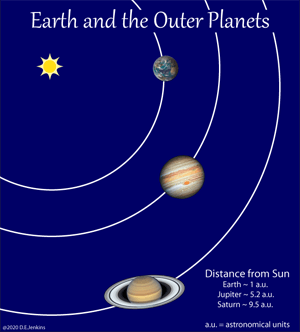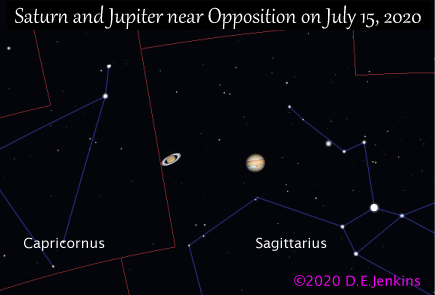
August 2020 - Vol. 24, No. 8
This Month's Night Sky - NOTE: The next paragraph describes the sky as it appears at 10 pm EST (11 pm EDT) near mid- month. The sky also looks this way at 11 pm EST (midnight EDT) during the beginning of the month and at 9 pm EST (10 pm EDT) by month's end.
Bright blue-white Vega (Lyra) shines high overhead as it "leads" the Summer Triangle across the night sky. The "Triangle" is the summer’s most prominent asterism and is made up of three stars: Vega, the brightest, Deneb (Cygnus) and Altair (Aquila). Scorpius and the bright star Antares occupy the southern sky. . Look for another famous asterism, “the teapot” (Sagittarius). The stars of constellations Scorpius and Sagittarius, embedded in the "Milky Way" (part of one of the spiral "arms" of our galaxy), are at their best this month. This year's Perseid shower occurs when the Moon is past third quarter so with good weather, an excellent meteor shower may be in the near future.
MERCURY shines brightly in the morning sky and reaching superior conjunction on the 17th. VENUS prominent in the morning sky shining brilliantly at -4.5 mag passing into Gemini in the middle of the month. MARS opens the month at -1.1 mag rising now around midnight. By month's end the disk will grow to 19" and the red planet will reach -1.8 magnitude. JUPITER past opposition now rises before the Sun sets. The giant planet is shining at -2.7 in Sagittarius moving in retrograde direction. SATURN also past opposition and retrograde in Sagittarius. The dance of these two planets is covered in the main topic below. URANUS reaches its first stationary point on the 15th and begins retrograde motion. NEPTUNE is also moving in a retrograde direction in Aquarius approaching opposition next month.
Review how to determine Angular Measurement.
Calendar of Events
NOTE: For those observers not in the ET zone, convert the calendar times to your zone's time by subtracting one hour for CT, two for MT and three for PT. Don't forget to adjust for Daylight Savings Time when necessary by subtracting one hour from your planisphere's time. Dawn and dusk times must also be corrected. See your local newspaper, TV news, or cable TV's Weather Channel for sunrise and sunset times or check with the U.S. Naval observatory. Unfortunately some of these events may occur during daylight hours in your area.
| DATE | EVENT |
| 02 |
Venus at greatest heliocentric lat. S. Jupiter 1.5 deg. N. of Moon. Saturn 2 deg. N. of Moon. Pluto 1.1 deg. N of Moon, occultation E Antarctica. |
| 03 |
Mars at perihelion. This month's full moon is called the "Sturgeon " Moon or "Grain "Moon. The full moon is low in the sky during the northern summer months. |
| 06 | Mercury at perihelion. |
| 09 |
Mars 0.8 deg. N. of Moon, occultation from W. Antarctica, SE S. America, Ascension Is. Moon at apogee. |
| 10 | Uranus 4 deg. N. of Moon. |
| 12 | Perseid meteor shower |
| 13 | Venus at greatest elongation W (46 deg.) |
| 15 |
Venus 4 deg. S. of Moon. Uranus stationary. |
| 16 | Mercury at greatest heliocentric lat. N. |
| 17 |
Moon 1.7 deg N. of Beehive cluster (M-44) Mercury at superior conjunction. |
| 21 | Moon at perigee. |
| 28 | Asteroid Ceres at opposition. |
| 29 | Jupiter 1.4 deg. N. of Moon. Saturn 2 deg. N. of Moon Pluto 1.2 deg. N of Moon, occultation Queen Maud land and most of W Antarctica. |
Lunar Almanac for August 2020
| Phases of the Moon | Phase and Date(s) | Best viewed before local midnight |
 |
New 20 |
Deep Space Objects |
 |
1st. Qtr 27 |
Planets & Moon |
 |
Full 05 |
Moon |
 |
Last Qtr 12 |
Deep Space & Planets |
Topic of the month: The Great Conjunction of Jupiter and Saturn 2020
 Since 2020 opened, we've discussed the "great conjunction" of Jupiter and Saturn
in the What's Up? almanac. This is the year when the gas giant Jupiter overtakes Saturn on its orbital path. But what exactly does that mean? Jupiter and Saturn are outer planets because they orbit the Sun outside of the Earth's orbit as shown in the graphic,. Note that the planets are not to scale, and planet Earth is tiny compared to the gas giants in the solar system.
Since 2020 opened, we've discussed the "great conjunction" of Jupiter and Saturn
in the What's Up? almanac. This is the year when the gas giant Jupiter overtakes Saturn on its orbital path. But what exactly does that mean? Jupiter and Saturn are outer planets because they orbit the Sun outside of the Earth's orbit as shown in the graphic,. Note that the planets are not to scale, and planet Earth is tiny compared to the gas giants in the solar system.
Jupiter is the largest planet in the solar system, containing about 99% of the mass outside of the Sun itself. Jupiter's orbit of the Sun takes 11.86 years to complete. The gas giant Saturn has a fabulous and famous ring. It takes 29.46 years for Saturn to make a complete circuit around the Sun. Jupiter will only catch up with Saturn twice in those 29 years. (Actually 2.48 times.) That is called, the great conjunction, and it is said to occur once in a generation. It means that Jupiter and Saturn will appear close together in the sky from Earth. It happens once every 20 years as all the planets keep making their rounds. Luckily for us,during the great conjunction of 2020, planet Earth is in a great position for observers to really enjoy the show. Jupiter and Saturn are over the horizon when it appears that Jupiter finally laps Saturn on December 21, 2020. Coincidentally, this is the day of Earth's Winter solstice this year, too!
What is a conjunction, anyway? Basically a conjunction is two astronomical bodies (Sun, Moon, planets, and even stars) that appear close to each other as viewed from a third body. For us, that third body is the Earth unless otherwise noted. It is important to realize that such conjunctions are merely "apparent" because light from astronomical objects is refracted by the Earth's atmosphere and this affects the position. There may also be more than two bodies in conjunction, in the case of Jupiter and Saturn during their great conjunction, a 3-day old Moon will pass 3 deg. S of Jupiter and Saturn while they are a mere .4 deg apart, making a triple conjunction!
They've been dazzling in the night sky for a few months now. Earth sped past Jupiter when the planets reached opposition on July 14, Jupiter was 180 deg. away from the Sun and shining brilliantly at -2.8. Telescopically, Jupiter is accompanied by 4 large moons first discovered by Galileo. Saturn was at opposition on July 20, shining at +0.1 mag., its rings tilted at 21.7 deg. toward Earth and a disk 18.4". Saturn's rings are made of ice crystals orbiting the planet at various distances. That is somewhat like the ridges on a vinyl record album. There is one large gap near the center of the rings, dividing them into two parts called "The Cassini Division." This gap can be seen with small telescopes and there are other gaps and variations in the crystals that can be seen with larger amateur instruments on a clear night. At opposition (when they are opposite the Sun in the sky as seen from Earth) both planets were in the constellation of Sagittarius.

The image above shows where Jupiter and Saturn were near the time of their oppositions - - 6 days apart. For the outer planets, opposition is the best time to observe them because they will be in the sky all night. They transit the meridian around midnight when they are highest in the sky. They rise as the Sun sets, shine all night and then set just before the Sun peaks over the horizon. From this point on, they will rise before the Sun sets, a bit earlier each day. Also, opposition is the time that the outer planets show their whole disk, that means the disk is 100% illuminated. Only outer planets appear with a fully illuminated disk because we can see them from Earth when the Sun is behind us.
Each opposition is known as an apparition, it begins when the planet first appears in the dawn sky. The planet moves in the sky until opposition is reached by Earth and the outer planet in their orbits. The apparition ends when the planet is last sighted on the western horizon at sunset. It should be said before closing that not all great conjunctions are visible from Earth. In 2020, during the last great conjunction, Jupiter crossed in front of Saturn when both planets were too close to the Sun to be observed. In 2040, Saturn and Jupiter will meet up again and perform a similar dance, this time at the western side of the constellation Virgo.
Future issues of the What's Up? almanac will continue this discussion of the Great Conjunction until the end of the year. Check it out each month as this once in a generation event flies past us in the night sky.
--See You Under the Stars!
Astra for Astra's Almanac
This installment of "What's Up?" is ©2020 by Dawn Jenkins for Astra's Stargate. View Ron Leeseburg's Farewell Issue for information on where to find information such as is presented in this almanac.
